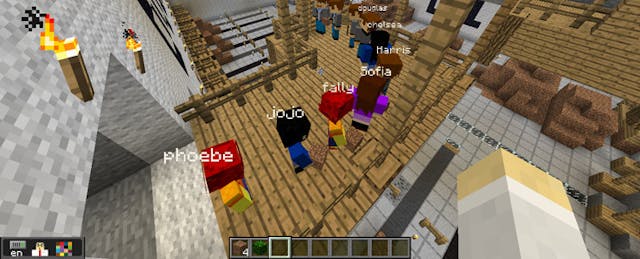Dig, dig, dig. Break and build. Such are the simple, hallmark mechanics behind one of the world’s most popular indie games, Minecraft, which has sold an estimated 20 million copies across different platforms and consoles since its alpha release in 2009.
That includes copies at more than 1,400 schools across six continents, shared Joel Levin, the "Minecraft Teacher" who many accredit for bringing the game into the classroom. Levin, who teaches computer science at Columbia Grammar and Preparatory School in New York City, is the co-creator of MinecraftEDU, the official version of the game specifically tailored for teachers and students. His popular blog serves as a nexus of the Minecraft educator community.
“I see myself more as a gardener,” Levin humbly stated in an interview at the recent 2013 Games for Change Festival."
And the garden that he’s nurtured has blossomed into a collection of colorful worlds, projects and contraptions of every imaginable scope and scale. Perhaps the grandest is the World of Humanities, made up of ancient cities and landmarks filled with additional readings, missions and quests for students. Its creator, Eric Walker, a teacher at the American School in Kuwait, has poured 600--and counting--hours into the project.
The popularity goes beyond the virtual world. It’s spawned summer camps and become a Halloween costume favorite.
MinecraftEDU dates to June 2011, when the crafty Levin reached out to Minecraft creator, Markus Persson, about introducing the game to schools. “He wanted to go in that direction but didn’t want to be involved with the cumbersome process,” said Levin. Persson agreed to let Levin create a school-friendly version that simplified technical issues such as setting up servers, managing account privileges, configuration scripts, and defining the limits of player space and options.
In October 2011, Levin and co-founder Santeri Koivisito formally incorporated TeacherGaming LLC. The company, which now consists of five people, licenses MinecraftEDU to schools on a per-seat basis. An average account of about 25 licenses runs $335.
MinecraftEdu.com offers a Wiki that serves as a 101 tutorial for setting up the game, as well as an active forum where anyone can share projects and ask questions. The interface is a little rough and disorganized, admitted Levin. He and his team hope to release some “major updates” within the next two to three months. Among the new offerings will be an organized library of Minecraft-related lesson plans submitted by teachers. The goal, Levin said, is to “be able to search by subject, duration, and find relevant maps and world templates.”
Levin insisted that MinecraftEDU wants to avoid telling teachers that this is the way to teach. And this sentiment was echoed by game designer Katie Salen, executive director of the Institute of Play who’s also involved in the design of game-based schools, Quest to Learn, in New York and Chicago. At the Games for Change Festival, she noted:
“What’s interesting about Minecraft is that it’s been taken up by teachers in all subject areas and used in radically different ways” from math and science to cyberbullying. “There’s a quality of Minecraft [in that] because it’s so simple in some ways...that teachers could immediately project into that space a sense of what they could do with it, rather than ‘this game comes to me wholly packaged in terms of what it wants to do for me and what it is going to do for our kids.’”
Levin noted, however, that the popularity of the game among students at home sometimes poses a new challenge to teachers. “When I started three years ago, I did it in a very controlled way because not many kids had known about it,” he said. “Now, kids come in with preconceived notion about how [Minecraft] should be played. They demand mods and abilities.”
His top advice for new Minecraft teachers: “Don’t just start playing.” Levin engages his students in a discussion about the context and goal before each Minecraft session. He’s found that MinecraftEDU sessions are most productive--and fun--when “teachers to talk to the kids about the meaning, purpose, rules, and how the world for the given project should operate.”
In many ways, Levin sees how students interact in the virtual world as a proxy for real-life social interactions. “The class needs to define the community. This may be contrary to kids’ instincts as gamers, which is very individualistic.”


